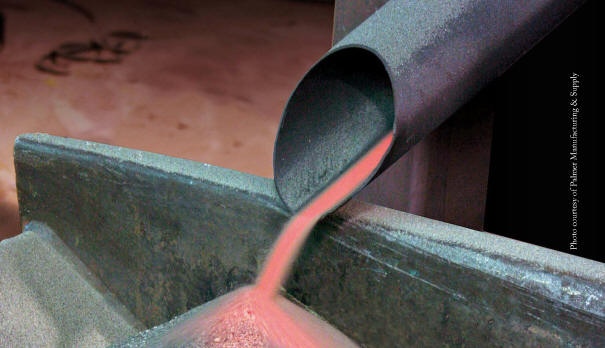Foundry & industrial processing Machinery EQUIPMENT & SYSTEMS
U.S. & Canada Call 1.800.457.5456
Who Is Choosing Thermal Sand Reclamation?
Home Articles Who Is Choosing Thermal Sand Reclamation?
Modern Casting Magazine, October, 2011 issue.
Republished with permission
Shanon Wetzel, Senior Edito

Three companies share why the process is a good fit for their casting operations, and seven vendors provide their equipment details.
Republished with permission from Modern Casting Magazine, October, 2011.
Shannon Wetzel, Senior Editor.
More than 10 years ago, EBAA Iron Co., Eastland, Texas, decided it was done trucking loads upon loads of sand in and out of the facility.
"We have a lot of things in Texas, but sand isn't one of them," said Dick Mead, plant engineering manager for EBAA. "In the past, we would bleed sand out of the system and replace it with new sand. That's expensive. Plus, we had the problem of disposing of used sand."
The waterworks casting manufacturer started with a 1,000-lb./hour thermal sand reclaimer that burns off binder so the sand can be used repeatedly. Because thermal sand reclamation units typically remove 90-100% of the binder, the reclaimed sand's properties are comparable to new sand. For EBAA, a large iron casting facility, the system seemed like a good investment.
"It makes sense to clean up what we have so it's usable," Mead said. "It's a capital expense, another piece of equipment, another baghouse. If you were somewhere where it was relatively easy to dispose of used sand or buying new sand was a minimal expense, it might be difficult to get the return on investment."
Justifying Cost
Like many metalcasting facilities in the U.S. Midwest, ThyssenKrupp Waupaca, Waupaca, Wis., was fine with its sand costs for many years. According to Gregory Miskinis, director of research and process development, ThyssenKrupp facilities had good, longstanding relationships with their sand suppliers, and land for sand disposal was plentiful and inexpensive. As a result, thermal sand reclamation couldn't be cost-justified.
But now the company is a step away from installing a thermal sand reclamation system in its Waupaca plants.
"Planning for the future led us to this point,"Miskinis said. "As good as a relationship as you can have with your sand suppliers, they still have to be responsible to their shareholders who are asking why they are selling to the foundry when so much can be sold to [the oil and gas industry] at a higher price. We looked at [the market] and knew we needed to protect our future raw material."
The oil and gas industry has turned up its demand for silica sand, which is used in the hydraulic fracturing (or fracking) process. The demand is threatening the supply to other industries dependent on sand, including the metalcasting industry. According to Miskinis, the potential sand shortage and increased costs are making it easier to cost-justify thermal sand reclamation."It's the right thing to do, as our CEO says," Miskinis said. "And now it has a payback period that is acceptable to our parent company."
ThyssenKrupp Waupaca has selected and engineered a system and plans to purchase the equipment in the first or second quarter of the next fiscal year.
Not Only for High Production
As a high volume casting facility, ThyssenKrupp Waupaca plans to run its thermal sand reclamation equipment constantly. The units are designed and built to provide a continuous amount of fresh sand to keep up with production.
At Space Castings, the foundry division of Flotech Inc., Jacksonville, Fla., the thermal sand reclamation unit runs just 50 hours a week.
"We're not a production foundry that kicks out 6,000 or 7,000 pieces of something," said Chris Casey, foundry operator. "We do a lot of one-, two- and three-offs."
Although Flotech is not dealing in the same volume of sand as ThyssenKrupp Waupaca or EBAA, the material's cost is still critical. According to Casey, available landfills are scarce in Florida and new sand has to be trucked in with a blower unit. His plant was spending $5,000 for 20 tons of sand.
"When you are spending $4,500 to $5,500 for a load of sand, and that's only a week's supply, it adds up," Casey said. "There are only so many times you can run mechanically reclaimed sand through [the system]. If you are doing 50% mechanical, 50% new, your costs are really going to start to go up."
Casey suggests a few considerations for metalcasters—particularly smaller volume shops—that are performing a cost-benefit analysis of thermal sand reclamation:
- Size of the unit.
- Energy costs.
- New sand costs.
- Disposal and haul-away costs.
Size Matters
In April 2008, Flotech upgraded its thermal sand reclamation to a 1-ton/hour unit. The system reclaims more than 99% of its sand, with the remainder lost to production and in fines, according to Casey.
"Disposal cost is one of the easiest areas to realize your savings," he said. "Our disposal costs have been reduced to negligible. Plus, what we do have to haul away is now just sand to be dumped and not a hazardous material."
Casey said the return on investment for the unit is expected to be three years. Energy costs have increased for the gas-fired unit, but Casey is satisfied with the fuel efficiency. New sand and disposal costs have been cut dramatically.
ThyssenKrupp Waupaca is taking a different approach to running its thermal reclamation system. It plans to keep it in operation constantly, so it had to size the system to match production.
We wanted a size that would provide the needs for our coreroom but also allow autonomous operation on nonproduction weekends and allow the sand to accumulate but not give us a mountain," Miskinis said. "We went with a system that processes 3 tons/hour but is designed so that we could easily double it in the same location if needed."
EBAA recently upgraded its 4,000-lb./hour system to 8,000 lbs./hour when it saw a marginal demand that would push its 4,000-1b. unit to run 24 hours a day six days a week.
"Running it like that was not a problem," Mead said. "But it looked like we would have to go to a second shift, which would mean we wouldn't have enough reclaim capacity."
At 8,000 lbs./hour, EBBA's new unit has more than enough capacity. Because the equipment works best when it runs continuously for a long period of time, the valve and pipe caster stores the sand that needs to be reclaimed.
Grading the Sand
When ThyssenKrupp Waupaca was researching thermal sand reclamation, one of its main concerns was the quality of the sand after processing.
"We wanted to find out the potential harm to the sand and compare it to the cost of purchasing new virgin sand and landfilling the end product," Miskinis said.
ThyssenKrupp Waupaca asked a thermal sand reclamation equipment supplier to run its sand through the system the metalcaster would be using. The sand then was sent to the company's resin suppliers for testing. ThyssenKrupp Waupaca also performed in-house testing.
"We wanted to know if we'd have something better or worse," Miskinis said. "In our case, we found there might be an advantage to thermally reclaiming for dimensional stability."
If ThyssenKrupp Waupaca is able to lower distortion in its coremaking material, it can reduce the amount of additives used to combat distortion-related defects.
"Looking at the sheer amount of money spent on those additives, reducing that by 50% would be a big win for us," Miskinis said.
Flotech's casting facility is so confident in its reclaimed sand that the material makes up 90% of the sand mixture. New sand is added to keep acid levels low.
Mead doesn't report advantages with EBAA's reclaimed sand, but he said it has performed up to the same standards as virgin sand.
"The highest compliment you can pay to reclaimed sand is that it is as good as new sand," he said.
Click here for more details about Palmer Thermal Sand Reclamation.
Copyright © 2024 Palmer Manufacturing & Supply, Inc. | Terms and Conditions | Privacy Policy
Web published by Marketing Options, LLC.




